Creating an engaging poster is an art that combines various elements to catch the eye and convey a message effectively. In the era of digital design, tools like a generative AI tool can assist in this creative process, but understanding the fundamentals of poster design is crucial. A well-designed poster can grab attention, communicate a message, and leave a lasting impression. Let’s explore the key elements that make a poster design truly engaging.
1. Striking Visuals
The visual impact of a poster is crucial in catching the viewer’s eye. This involves selecting images, colors, and graphics that are attention-grabbing and relevant to the poster’s message. The quality of images is important; they should be high-resolution and professionally rendered. Creative graphics can add a unique touch, differentiating your poster from others. Color choice is equally important as different colors evoke different emotions.
Bright and bold colors might suit an energetic event, while a more subdued palette could be used for a serious topic. The key is to create a visual harmony that aligns with the message while being visually stimulating.
2. Clear and Concise Message
The effectiveness of a poster largely depends on its ability to convey its message quickly and clearly. The main message should be the most prominent text element and should be easily understandable at a glance. Overloading the poster with too much text can be counterproductive, as it can overwhelm the viewer and dilute the main message. When choosing a font, readability is paramount.
The font style should complement the overall design aesthetic and tone of the poster. It’s also important to consider the hierarchy of the text, ensuring that the most important information stands out.
3. Effective Use of Space
A well-organized poster layout is essential to balance the various elements – text, images, and white space. Effective use of space can make a poster look more professional and easier to digest. White space, or negative space, is not just space; it helps highlight the poster’s key elements by reducing clutter. A good layout guides the viewer’s eye logically, ensuring that all the essential information is noticed. The spatial arrangement should create a visual journey, leading the viewer from the main message to secondary information.
4. Target Audience Relevance
A poster should speak directly to its intended audience. This means considering the preferences and interests of your target demographic in your design choices. For instance, a youth-oriented event might benefit from a trendy, vibrant design, while a corporate seminar might require a more subdued and formal approach. Understanding your audience influences not just the choice of visuals and colors, but also the tone of the message.
5. A Call to Action
An effective poster usually prompts some form of action from its viewers. This call to action (CTA) should be clear and prominently placed. Whether it’s inviting people to an event, encouraging them to visit a website, or asking them to participate in a social initiative, the CTA needs to be direct and compelling. It should stand out but also integrate seamlessly with the rest of the design. The CTA is the final push that can convert a viewer’s interest into actual engagement or participation.
For your creative needs, Adobe experts say, “Find the right Adobe Firefly plan for you.”
A captivating poster design is a blend of striking visuals, clear messaging, effective use of space, audience relevance, and a compelling call to action. By focusing on these elements, you can create posters that not only catch the eye but also effectively communicate your message and engage your audience.


